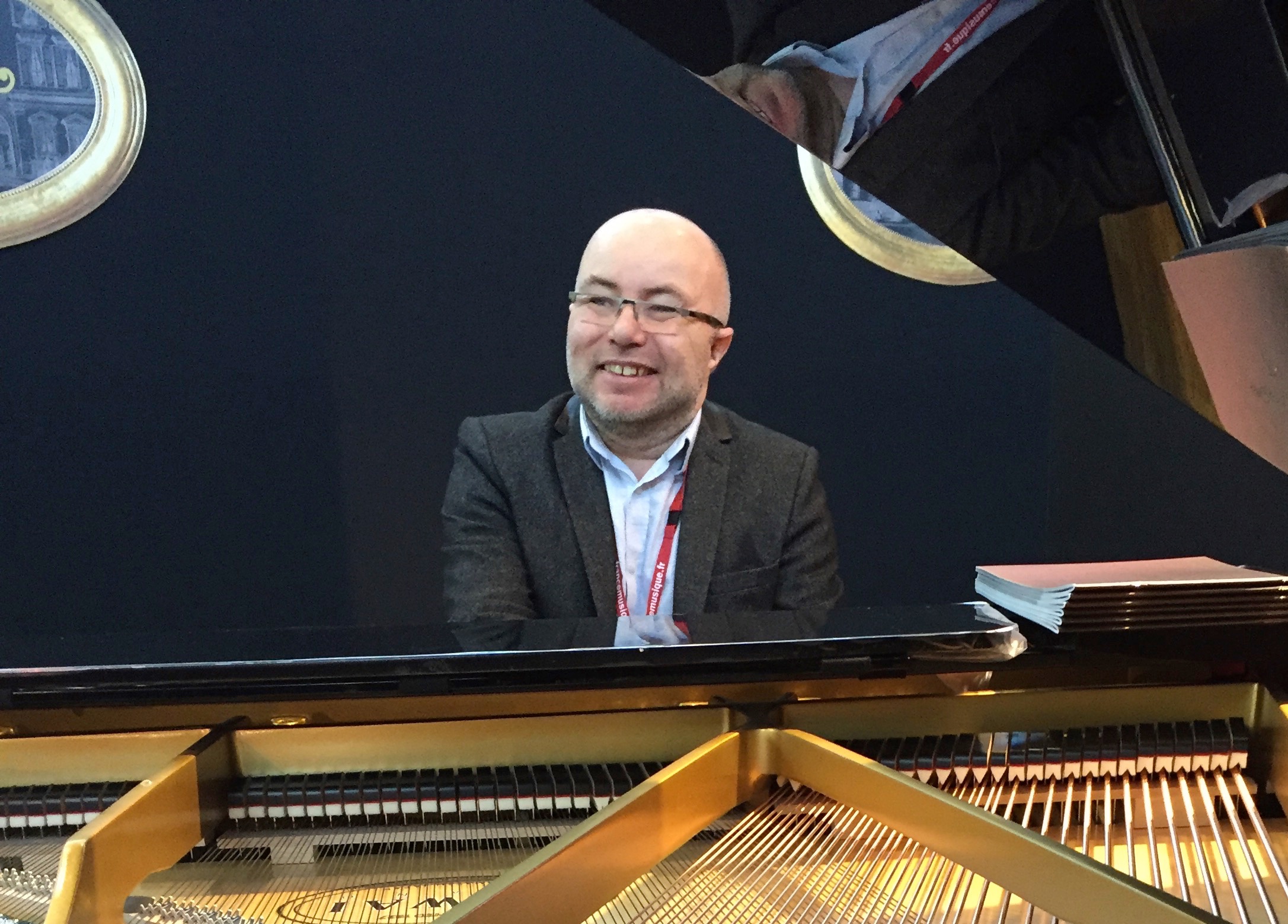-
Posts
1,066 -
Joined
-
Last visited
Reputation Activity
-
 Stephane Boussuge reacted to JulioHerrlein in Apple M1 Arm processor?
Stephane Boussuge reacted to JulioHerrlein in Apple M1 Arm processor?
Amazing feature, Janusz !
This is new Notation Viewer is a very useful feature, especially for dealing with long excerpts of music. It really helps a lot when hearing the pieces to make decisions about the form, the duration of the textures.
Does it works also with the ps (preview score) function ?
Looking forward to see it in Windows machines !
All the best !
Julio
-
 Stephane Boussuge reacted to opmo in OM v.3.0 (Notation Viewer)
Stephane Boussuge reacted to opmo in OM v.3.0 (Notation Viewer)
I hope you like the upcoming Notation viewer. Opusmodus v.3.0 screenshot.
Coming soon.
OM-v.3.0-Notation-Viewer.mp4
-
 Stephane Boussuge reacted to AM in conTimbre library + pitchbend
Stephane Boussuge reacted to AM in conTimbre library + pitchbend
dear all
conTimbre-library works (in the next update) perfect with TUNING (midi-pitchbend) and PAN now. thanx to thomas hummel and janusz!
here are some simple sound examples...
ct-micro+pan2.aiff
ct-micro+pan3.aiff
ct-micro+pan.aiff
ct-micro+pan4.aiff
-
 Stephane Boussuge reacted to JulioHerrlein in Instant No.1 pour Piano (2022)
Stephane Boussuge reacted to JulioHerrlein in Instant No.1 pour Piano (2022)
Beautiful, Stephane !
BEst,
Julio
-
 Stephane Boussuge got a reaction from NagyMusic in Instant No.1 pour Piano (2022)
Stephane Boussuge got a reaction from NagyMusic in Instant No.1 pour Piano (2022)
New short piece for Piano.
Stéphane
Instant1-V1Edit03Render1.mp3 instant1v1-01Edit3.pdf Instant1V1-01.opmo
-
 Stephane Boussuge got a reaction from JulioHerrlein in Instant No.1 pour Piano (2022)
Stephane Boussuge got a reaction from JulioHerrlein in Instant No.1 pour Piano (2022)
New short piece for Piano.
Stéphane
Instant1-V1Edit03Render1.mp3 instant1v1-01Edit3.pdf Instant1V1-01.opmo
-
 Stephane Boussuge got a reaction from AM in Instant No.1 pour Piano (2022)
Stephane Boussuge got a reaction from AM in Instant No.1 pour Piano (2022)
New short piece for Piano.
Stéphane
Instant1-V1Edit03Render1.mp3 instant1v1-01Edit3.pdf Instant1V1-01.opmo
-
 Stephane Boussuge got a reaction from o_e in Instant No.1 pour Piano (2022)
Stephane Boussuge got a reaction from o_e in Instant No.1 pour Piano (2022)
New short piece for Piano.
Stéphane
Instant1-V1Edit03Render1.mp3 instant1v1-01Edit3.pdf Instant1V1-01.opmo
-
 Stephane Boussuge got a reaction from JulioHerrlein in Distribute Stream option/keyword
Stephane Boussuge got a reaction from JulioHerrlein in Distribute Stream option/keyword
Hi Julio,
the distribution is not made according to beats but just in order based on delta-time.
But I agree I would like to have more control on distribution like the possibility to distribute list of pitch structure on vertical events (events with the same delta time) to be able to get a better control on the resultant harmonies.
Best
Stéphane
-
 Stephane Boussuge got a reaction from o_e in Distribute Stream option/keyword
Stephane Boussuge got a reaction from o_e in Distribute Stream option/keyword
Hi Julio,
the distribution is not made according to beats but just in order based on delta-time.
But I agree I would like to have more control on distribution like the possibility to distribute list of pitch structure on vertical events (events with the same delta time) to be able to get a better control on the resultant harmonies.
Best
Stéphane
-
 Stephane Boussuge reacted to AM in gen-summationsakkord / claus kühnl
Stephane Boussuge reacted to AM in gen-summationsakkord / claus kühnl
an example with 2 pitches = 2 intervals, with microtonal quantification
(sort-asc (remove-duplicates (pitch-melodize (append (gen-summationsakkord '(3 5) :typ 'ks :gedachter-grundton 'db0 :quant nil) (gen-summationsakkord '(5 7) :typ 'ks :gedachter-grundton 'db0 :quant nil))))) (sort-asc (remove-duplicates (pitch-melodize (append (gen-summationsakkord '(3 5) :typ 'gs :gedachter-grundton 'db0 :quant nil) (gen-summationsakkord '(5 7) :typ 'gs :gedachter-grundton 'db0 :quant nil)))))
-
 Stephane Boussuge reacted to AM in gen-summationsakkord / claus kühnl
Stephane Boussuge reacted to AM in gen-summationsakkord / claus kühnl
here ist some code to generate "Summationsakkorde" (CLAUS KüHNL)... have a look to the PDF...
(from the book "Claus Kühnl: Beiträge zu einer HArmonielehre 2000" Friedrich Hofmeister Musikverlag. p.42+)
;;;;;;;;;;;;;;;;;;;;;;;;;;;;;;;;;;;;;;;;;;;;;;;;;;;;;;;;;;;;;;;;;;;;;;;;;;;;;;;;;;;;;;;;;;;;;;;;;;;;;;;;;;;;;; (defun gen-summationsakkord (primaerint &key (n 10)(typ 'ks) (gedachter-grundton 'c0) (quant 1/2) (chord t)) (let ((partial-reihe (hertz-to-pitch (harmonics gedachter-grundton 100 :type :hertz) :quantize quant)) (partial-liste (remove-duplicates (append primaerint (list (sum primaerint)) (loop repeat n with k-int = (sum primaerint) with g-int = (sum primaerint) with a = (first primaerint) with b = (second primaerint) collect (cond ((equal typ 'ks) (setf k-int (+ (car primaerint) k-int))) ((equal typ 'gs) (setf g-int (+ (second primaerint) g-int))) ((equal typ 'fibo) (shiftf a b (+ a b))))))))) (if (null chord) (position-filter (x-b partial-liste 1) partial-reihe) (chordize (position-filter (x-b partial-liste 1) partial-reihe))))) ;;;;;;;;;;;;;;;;;;;;;;;;;;;;;;;;;;;;;;;;;;;;;;;;;;;;;;;;;;;;;;;;;;;;;;;;;;;;;;;;;;;;;;;;;;;;;;;;;;;;;;;;;;;;;; (gen-summationsakkord '(2 3) :typ 'ks :gedachter-grundton 'c2) (gen-summationsakkord '(2 3) :typ 'gs :gedachter-grundton 'c2) (gen-summationsakkord '(2 3) :typ 'fibo :gedachter-grundton 'c2) (gen-summationsakkord '(2 3) :typ 'ks :gedachter-grundton 'c2 :quant nil) (gen-summationsakkord '(3 4) :typ 'ks :gedachter-grundton 'f1) (gen-summationsakkord '(3 4) :typ 'gs :gedachter-grundton 'f1) (gen-summationsakkord '(3 4) :typ 'fibo :gedachter-grundton 'f1)
Doc - 03.08.2022 - 20-41.pdf
-
 Stephane Boussuge reacted to AM in Make arpeggio
Stephane Boussuge reacted to AM in Make arpeggio
here is a possible solution...
;;;;;;;;;;;;;;;;;;;;;;;;;;;;;;;;;;;;;;;;;;;;;;;;;;;;;;;;;;;;;;;;;;;;;;;;;;;;;;;;;;;;;;;;;;;;;;;;;;;;;;;;;;;;;;;;;;;;;;;;;;;;;;;;;;;;; ;;; THE FUNCTION ;;;;;;;;;;;;;;;;;;;;;;;;;;;;;;;;;;;;;;;;;;;;;;;;;;;;;;;;;;;;;;;;;;;;;;;;;;;;;;;;;;;;;;;;;;;;;;;;;;;;;;;;;;;;;;;;;;;; ;;;;;;;;;;;;;;;;;;;;;;;;;;;;;;;;;;;;;;;;;;;;;;;;;;;;;;;;;;;;;;;;;;;;;;;;;;;;;;;;;;;;;;;;;;;;;;;;;;;;;;;;;;;;;;;;;;;;;;;;;;;;;;;;;;;;; (defun gen-arpeggio (event &key (rhy'(1/28)) (legato nil)) (let* ((pitches (melodize (omn :pitch event))) (length (car (omn :length event))) (velo (car (omn :velocity event))) (art (car (omn :articulation event))) (rhy (gen-repeat 10 rhy)) (arpeggio-voices (loop repeat (length pitches) for i from 0 to (1- (length pitches)) for j in pitches for rhy in rhy collect (if (= i 0) (length-rational-quantize (list rhy j velo art) :round length) (length-rational-quantize (append (gen-length (list i) (* -1 rhy)) (list rhy) (list j) (list velo) (list art)) :round length))))) (assign-variable 'voice (if (null legato) arpeggio-voices (loop for x in arpeggio-voices collect (length-legato x)))))) ;;;;;;;;;;;;;;;;;;;;;;;;;;;;;;;;;;;;;;;;;;;;;;;;;;;;;;;;;;;;;;;;;;;;;;;;;;;;;;;;;;;;;;;;;;;;;;;;;;;;;;;;;;;;;;;;;;;;;;;;;;;;;;;;;;;;; ;;; IT WORKS LIKE THAT ;;;;;;;;;;;;;;;;;;;;;;;;;;;;;;;;;;;;;;;;;;;;;;;;;;;;;;;;;;;;;;;;;;;;;;;;;;;;;;;;;;;;;;;;;;;;;;;;;;;;;;;;;;;;;; ;;;;;;;;;;;;;;;;;;;;;;;;;;;;;;;;;;;;;;;;;;;;;;;;;;;;;;;;;;;;;;;;;;;;;;;;;;;;;;;;;;;;;;;;;;;;;;;;;;;;;;;;;;;;;;;;;;;;;;;;;;;;;;;;;;;;; ;;; type in ONE single-event (l p v a) with CHORD... for example: (setf event '(q c4e4g4b4 mf ten)) ;;; evaluate the function (with a arpeggio-length, for example :ryh 1/28) (gen-arpeggio event :rhy 1/28) ; now the the result are "bounded" on 4 voices/variables = the number of the chord-pitches ; => (voice1 voice2 voice3 voice4) ;;; list every variable, so you will have the four "arpeggio-rhythm/times", so you can use that for 4 parts on your score (list voice1) (list voice2) (list voice3) (list voice4) ;;; VARIANTS AND OPTIONS ;;;;;;;;;;;;;;;;;;;;;;;;;;;;;;;;;;;;;;;;;;;;;;;;;;;;;;;;;;;;;;;;;;;;;;;;;;;;;;;;;;;;;;;;;;;;;;;;;;;;;;;;;;;; ;;; if you choose ":legato t" => all the voices are like with PEDAL played (gen-arpeggio event :rhy 1/28 :legato t) ;;; if you want to put/merge all that into ONE VOICE just: (merge-voices voice1 voice2 voice3 voice4) => (7q c4 ten e4 ten g4 ten b4 ten -7h.) ;;; if you want to have different rhy's just do it like that (gen-arpeggio event :rhy '(1/28 1/20 1/12 1/8)) ;;;;;;;;;;;;;;;;;;;;;;;;;;;;;;;;;;;;;;;;;;;;;;;;;;;;;;;;;;;;;;;;;;;;;;;;;;;;;;;;;;;;;;;;;;;;;;;;;;;;;;;;;;;;;;;;;;;;;;;;;;;;;;;;;;;;;
-
 Stephane Boussuge reacted to opmo in Length-Displace Function
Stephane Boussuge reacted to opmo in Length-Displace Function
single-events then rotation
(setf omn (single-events '(-e he. d4 mf e cs4 hs eb4))) (gen-rotate -1 omn) => ((he. d4 mf) (e cs4 mf) (hs eb4 mf) (-e)) (gen-rotate -2 omn) => ((e cs4 mf) (hs eb4 mf) (-e) (he. d4 mf))
-
 Stephane Boussuge got a reaction from o_e in Generation of appoggiatura and accacciatura
Stephane Boussuge got a reaction from o_e in Generation of appoggiatura and accacciatura
In many scores, Pierre Boulez use a lot of accacciatura or appoggiatura , for exemple like in Dérive (1984), a score composed for and based on the name SACHER (famous hexachord used also in "Message esquisse").
Here's a function to help to add such appoggiature in your score based on a list of rhythmic values.
There is a draft doc in French joined to the function definition.
Hope it could be useful for some of us and may be improved and better coded and refined.
My best to all of Opmo users.
SB.
gen-ornament.lisp gen-ornament.rtfd.zip
-
 Stephane Boussuge got a reaction from AM in Generation of appoggiatura and accacciatura
Stephane Boussuge got a reaction from AM in Generation of appoggiatura and accacciatura
In many scores, Pierre Boulez use a lot of accacciatura or appoggiatura , for exemple like in Dérive (1984), a score composed for and based on the name SACHER (famous hexachord used also in "Message esquisse").
Here's a function to help to add such appoggiature in your score based on a list of rhythmic values.
There is a draft doc in French joined to the function definition.
Hope it could be useful for some of us and may be improved and better coded and refined.
My best to all of Opmo users.
SB.
gen-ornament.lisp gen-ornament.rtfd.zip
-
 Stephane Boussuge got a reaction from JulioHerrlein in Generation of appoggiatura and accacciatura
Stephane Boussuge got a reaction from JulioHerrlein in Generation of appoggiatura and accacciatura
In many scores, Pierre Boulez use a lot of accacciatura or appoggiatura , for exemple like in Dérive (1984), a score composed for and based on the name SACHER (famous hexachord used also in "Message esquisse").
Here's a function to help to add such appoggiature in your score based on a list of rhythmic values.
There is a draft doc in French joined to the function definition.
Hope it could be useful for some of us and may be improved and better coded and refined.
My best to all of Opmo users.
SB.
gen-ornament.lisp gen-ornament.rtfd.zip
-
 Stephane Boussuge reacted to opmo in remove rest(s) with dictum
Stephane Boussuge reacted to opmo in remove rest(s) with dictum
Done.
(dictum '(:remove e4) '(e c4 d4 e4 fs4 -q)) => (e c4 mf d4 - fs4 -q) (dictum '(:remove -q) '(e c4 d4 e4 fs4 -q)) => (e c4 mf d4 e4 fs4) (dictum '(:apply (length-rest-remove x)) '(e c4 d4 e4 fs4 -q)) => (e c4 d4 e4 fs4)
-
 Stephane Boussuge reacted to opmo in remove rest(s) with dictum
Stephane Boussuge reacted to opmo in remove rest(s) with dictum
To get:
(dictum '(:apply (length-rest-remove x)) '(w c5 ped -e)) => '(w c5 ped)
I would need to make some changes how the dictum deals with rests.
I will see what I can do.
-
 Stephane Boussuge reacted to opmo in split-point
Stephane Boussuge reacted to opmo in split-point
This will fix if length-rest list:
(defun split-point (split-points omn-seq) (do-verbose ("split-point") (let* ( (spltconvert (if (numberp (car split-points)) split-points (pitch-to-integer split-points))) (spltp (gen-trim (length omn-seq) spltconvert)) (p1 (loop for sp in spltp for l in omn-seq collect (if (length-restsp l) l (ambitus-filter `(,sp 128) l)) )) (p2 (loop for sp in spltp for l in omn-seq collect (if (length-restsp l) l (ambitus-filter `(-128 ,(- sp 1)) l)) )) ) (list p1 p2)))) -
 Stephane Boussuge reacted to AM in permute by rule
Stephane Boussuge reacted to AM in permute by rule
(defun permute-by-rule (n rule row) (append (list row) (loop repeat n collect (setf row (position-filter rule row))))) ;; row => a row (or a list) ;; n => number of generations ;; rule => new position/order in every generation - keep attention it's 0-based!!! => for 12 pitches use 0 to 11 (permute-by-rule 20 '(2 0 1 5 11 3 8 6 4 9 10 7) (make-scale 'c4 12))
-
 Stephane Boussuge got a reaction from JulioHerrlein in Dictum question
Stephane Boussuge got a reaction from JulioHerrlein in Dictum question
(setf omn4 '((e b4 fs5 e3 a5) (e e5 b5 c4) (e g5 a4 eb3 d4) (e c6 b5 a4) (e c5 eb5 gs4) (e b4 f5 f5 fs5 gs5 a5) (e cs4 g4 c6) (e gs5))) (dictum '((:butlast leg :bar (1 3 6)) (:apply stacc :bar (2 4 5)) (:any e :apply q :bar (1 3 6)) (:first p :bar 1) (:apply < :bar 1 :event 2..4) (:apply < :bar 2 :event 1..2) (:apply ff :bar 4) (:apply > :bar 5) (:first pp :bar 7) (:apply < :bar 7 :event 2..3) (:apply fff :bar 8) (:last fermata :bar 8)) omn4) S.
-

-
 Stephane Boussuge reacted to JulioHerrlein in How to retrieve parts from the 12-tone matrix
Stephane Boussuge reacted to JulioHerrlein in How to retrieve parts from the 12-tone matrix
FOUND IT !!!
(get-form-set '(0 4 9 10 5 3 8 7 1 2 11 6) 'r7)
-







